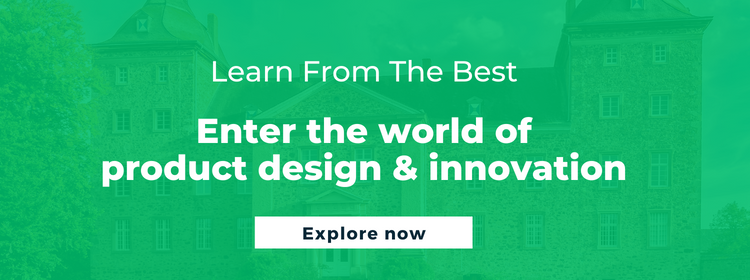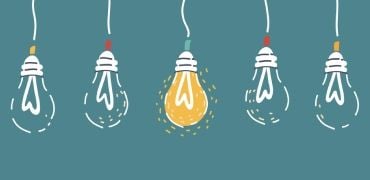How to Become a Product Designer in 2022: Solve Problems With Design

The term ‘product’ is generally used in relation to something tangible — a piece of clothing, furniture, or a household item. However, today, mobile applications and websites are categorized as modern digital products created using innovative designs to solve common, and sometimes uncommon problems. The design process and creative principles that a product designer uses are what eventually set a digital product apart from its competitors. But how does design impact user experience, and moreover, how to become a product designer?
What is Product Design?
Product design enhances user experiences by creating design-based solutions for new products or fixing existing ones. In essence, the foundation of this process lies in design thinking, which revolves around prioritizing customer needs above everything else.
Design processes are commonly used to create physical objects and manufactured products like cars, mobile phones, furniture, and many others. This branch of product design is called industrial design. Similarly, product design has also become an essential part of the tech world. It helps create seamless digital interfaces such as applications, software, websites, etc. Check out our recent article, what is product design, for a more comprehensive answer to this question. Otherwise, keep reading to learn more about how to become a product designer!
What Does a Product Designer Do?
A product designer’s job is to enable a smooth user experience through design. They get to wear multiple hats and execute end-to-end development by establishing a comprehensive design process. Generally, the day-to-day responsibilities cover research, ideation, designing, prototyping, and product testing.
1. Research and Analysis
 Evaluate the market and conduct in-depth research to understand the product better. This is called user research and usually happens through interviews, surveys, and market research. User analysis is the process of drawing conclusions based on user research data. This helps us define core user issues and have a clear objective.
Evaluate the market and conduct in-depth research to understand the product better. This is called user research and usually happens through interviews, surveys, and market research. User analysis is the process of drawing conclusions based on user research data. This helps us define core user issues and have a clear objective.
2. Ideation
This is where creative and strategic thinking combines to generate a series of design ideas: a product designer brainstorms and works on developing innovative solutions that target conclusions drawn from user analysis.
3. Design Process
Once the design concepts are approved, a product designer will begin creating the designs. This is done through sketching or computer-aided design (CAD), depending on the product specifications.
4. Create Prototypes
Product designers then work on building prototypes, bringing the design concept to life. This may involve sketching or 3D designs. This step often helps the designer check if they are on the right path and make any necessary changes.
5. Prototype Testing
Post prototype development, product designers will test these prototypes with real users to validate the designs and make any necessary amends based on customer feedback. In addition, they may conduct A/B testing and create journey maps, wireframes, or final mock-ups to build the right product that aligns with the customer’s needs.
How to Become a Product Designer?
Step 1: Evaluate the Skills Required
If you’re wondering how to become a product designer, the best way to break into the world of product design is by equipping yourself with the right skill sets. Apart from technical skills like interaction and visual design, coding, and information architecture, you must also have soft skills such as empathy, problem-solving and analytical thinking to be a successful product designer.
Step 2: Qualification Requisites
Many successful product designers do not have formal qualifications in the field. Now, while a university degree may not be mandatory, having one will surely set you apart from competitors. Moreover, you can specialize in a field of your choice.
At Emeritus, you can choose from a wide range of product design programs that collaborate with global institutes. These can help you fast-track your career trajectory and build your portfolio.
Step 3: Learn the Technical Skills
Essential product design skills include learning coding languages like HTML, C++, CSS, UI/UX design, prototyping, user research, testing, and visual design.
Step 4: Upgrade Your Skills With an Online Course
Since technology is rapidly evolving, keeping yourself updated on the latest developments and newest trends in the product design field is crucial. An online course can help improve your design skills and boost career growth. Check out online courses at Emeritus to enhance your career in product design.
Step 5: Create a Strong Portfolio
As with any other design field, gaining experience in product design can be incredibly beneficial. Internships, freelance projects, or volunteering with small enterprises will not only help you prepare to work in the industry but will also help you polish your skills.
Step 6: Build Your Network
Creating a network of like-minded professionals in the product design industry can be a great source of inspiration. It can help you explore prospective job roles in the field, find clients, or even build a design community with other budding design enthusiasts. Attending conferences, workshops, seminars, and meetups are great ways to make your network.
Step 7: Find a Mentor
As a beginner, it can be confusing to tackle challenging design aspects. A mentor in the product design space can guide you in the right direction and help you through challenges. In addition, having a mentor can motivate you to tap into your potential and get constructive feedback on your work.
Is Product Design a Good Career Option?
Product design can be an extremely lucrative career path for those who have a flair for two things – problem-solving and design. An analytical mind can help identify gaps in the service from a customer perspective, whereas a creative mind will transform these gaps into valuable designs that improve their functionality.
According to the U.S. Bureau of Labor and Statistics, the employment rate for industrial designers is projected to grow by 3% from 2021 to 2031.
Since technology constantly evolves, every aspect of the modern world feels an impact. This is why product design has applications in every industry, from e-commerce and electronics to furnishing and medical devices. Therefore, while there is a wide range of job opportunities in the field, the prospects and salary will vary based on your specialization.
Some of the most popular specializations in the field are visual design, UI/UX design, interaction design, spatial designer, and color technology.
ALSO READ: What is the Best Product Designer Salary in the Global Market?
What is the Average Salary for a Product Designer?
Typically, the average salary for a professional product designer is $120,000. However, the amount will likely vary based on your location, position, qualification, and experience in the field. For example, a lead product designer will earn around $67,130 median salary, whereas the salary for an entry-level position is about $56,479 per annum.
Is it Hard to Switch to a Product Design Career?
Taking that leap of faith from a different discipline to a product design career may seem intimidating. However, nothing is impossible if you have the interest and aptitude to be part of the design industry.
The first step would be to do your research on the skills needed to become a product designer. Next, start exploring the qualification route you want to pursue to learn the technical skills. An online course or a product design bootcamp are the most viable options for a smooth career transition. These can equip you with the fundamentals of the industry in a short time. You can then work on building a professional portfolio by taking up small-scale projects or freelance work. Moreover, if you are a problem solver, a good communicator, and have an eye for creativity, transitioning into a product design career should be relatively easy.
Once you have learned the basic principles of human-centric design, you will start understanding the scope of product design and how it works. Check out our portfolio of online product design courses and join the world of product design. After all, there is a reason why product design is one of the best career options for 2022.
By Priya Iyer Vyas
Write to us at content@emeritus.org






